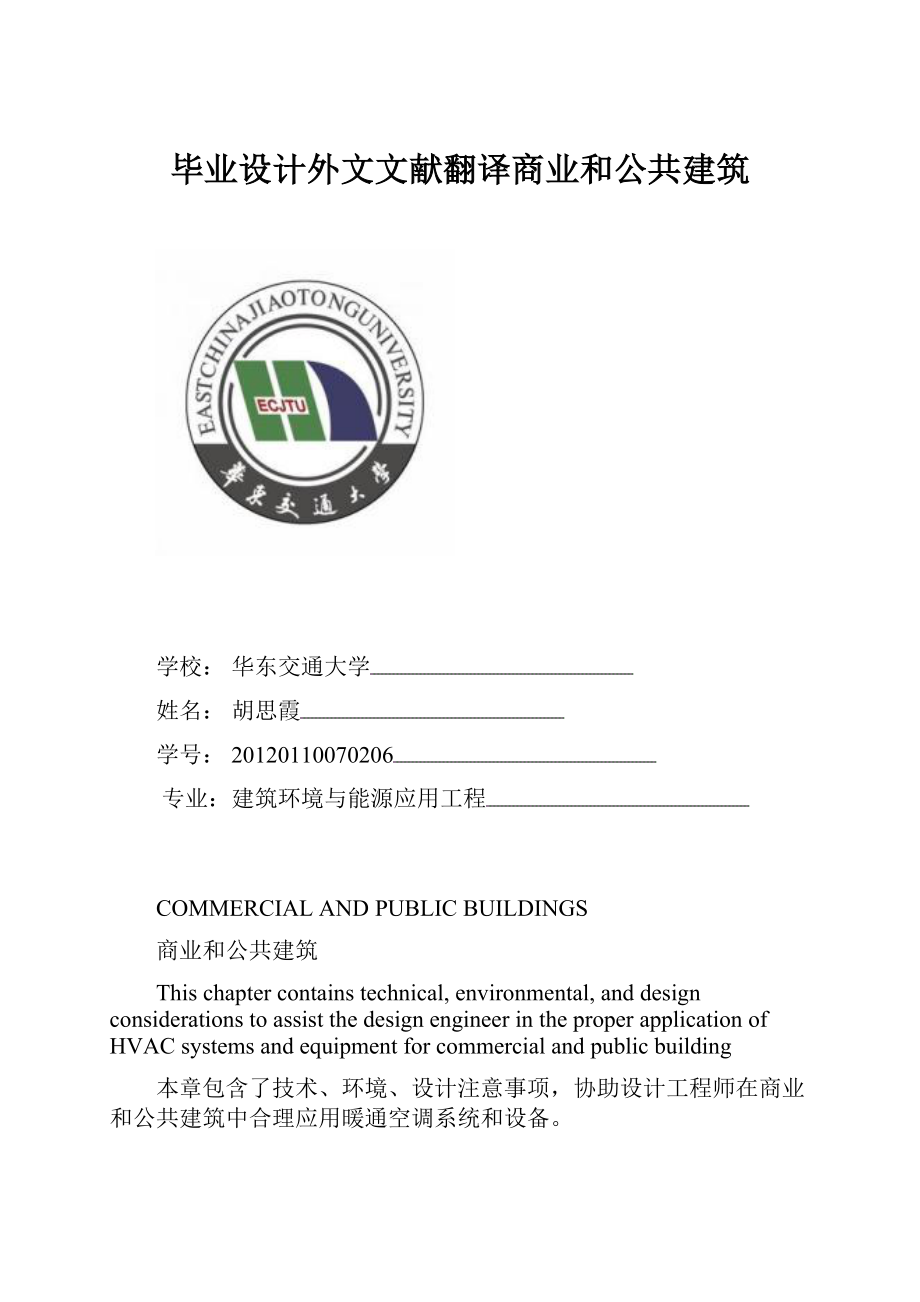毕业设计外文文献翻译商业和公共建筑.docx
《毕业设计外文文献翻译商业和公共建筑.docx》由会员分享,可在线阅读,更多相关《毕业设计外文文献翻译商业和公共建筑.docx(62页珍藏版)》请在冰点文库上搜索。

毕业设计外文文献翻译商业和公共建筑
学校:
华东交通大学
姓名:
胡思霞
学号:
20120110070206
专业:
建筑环境与能源应用工程
COMMERCIALANDPUBLICBUILDINGS
商业和公共建筑
Thischaptercontainstechnical,environmental,anddesignconsiderationstoassistthedesignengineerintheproperapplicationofHVACsystemsandequipmentforcommercialandpublicbuilding
本章包含了技术、环境、设计注意事项,协助设计工程师在商业和公共建筑中合理应用暖通空调系统和设备。
OFFICEBUILDINGS
办公建筑
GeneralDesignConsiderations
一般设计条例
Despitecyclicalmarketfluctuations,officebuildingsareconsideredthemostcomplexandcompetitivesegmentsofrealestatedevelopment.Surveydataof824000officebuildings(EIA2003)demonstratethedistributionoftheU.S.officebuildingsbythenumbersandthearea,asshowninTable1.AccordingtoGause(1998),anofficebuildingcanbedividedintothefollowingcategories:
尽管市场周期性的波动,写字楼依然被认为是最复杂和最具竞争力的房地产开发领域。
824000个办公楼调查数据(EIA2003)中的数目和地区显示了美国办公建筑的分布,如表1所示。
根据高斯(1998),办公楼可分为以下几类:
Class.Themostbasicfeature,classrepresentsthebuilding'squalitybytakingintoaccountvariablessuchasage,location,buildingmaterials,buildingsystems,amenities,leaserates,etc.Officebuildingsareofthreeclasses:
A,B,andC.ClassAisgenerallythemostdesirablebuilding,locatedinthemostdesirablelocations,andofferingfirst-ratedesign,buildingsystems,andamenities.ClassBbuildingsarelocatedingoodlocations,havelittlechanceoffunctionalobsolescence,andhavereasonablemanagement.ClassCbuildingsaretypicallyolder,havenotbeenmodernized,areoftenfunctionallyobsolete,andmaycontainasbestos.TheselowstandardsmakeClassCbuildingspotentialcandidatesfordemolitionorconversiontoanotheruse
等级。
最基本的功能,等级代表建筑的质量,考虑到各种变量,如年龄,位置,建筑材料,建筑系统,设施,租赁率等。
办公楼有三类:
A,B,和C。
A类一般是最理想的建筑,位于最理想的位置,并提供一流的设计,建筑系统和设施。
B类建筑位于很好的位置,有功能性贬值的机会很小,并有合理的管理。
C类建筑通常是旧的,没有现代化,往往是功能性废弃,并可能含有石棉。
这些低水平的建筑有可能被拆除或转换为另一种用途
SizeandFlexibility.Officebuildingsaretypicallygroupedintothreecategories:
highrise(16storiesandabove),midrise(fourto15stories),andlowrise(onetothreestories)Location.Anofficebuildingistypicallyinoneofthreelocations:
downtown(usuallyhighrises),suburban(low-tomid-risebuildings),orbusiness/industrialpark(typicallyone-tothreestorybuildings).
尺寸和灵活性。
办公楼通常分为三类:
高层(16层和以上),中高层(四至15层),低层(一至三层)位置。
办公楼通常在三个地点之一:
市中心(通常是高层建筑,郊区(低到中高层建筑),或商业/工业园区(通常是一到三层楼)。
Floorplate(FloorSpaceArea).Sizetypicallyrangesfrom1670to2800m2andaveragesfrom1860to2320m2.
地板(地板面积)。
大小通常为1670至2800平方米,平均为1860至2320平方米。
Useandownership.Officebuildingscanbesingletenantormultitenant.Asingle-tenantbuildingcanbeownedbythetenantorleasedfromalandlord.FromanHVAC&Rsystemsstandpoint,asingletenant/ownerismorecautiousconsideringissuessuchaslife-cyclecostandenergyconservation.Inmanycases,thesystemsarenotselectedbasedonthelowestfirstcostbutonlife-cyclecost.Sometimes,thedevelopermaywishtoselectasystemthatallowsindividualtenantstopaydirectlyfortheenergytheyconsume.
使用权和所有权。
办公楼可单租户或多租户。
单租户的建筑可以归承租人或出租的房东。
从暖通空调系统的角度来看,一个单一的租户/业主更需要谨慎考虑问题,如生命周期成本和节能。
在许多情况下,系统是不是基于最低的第一成本,但在生命周期成本的基础上,开发商可能希望选择一个系统,允许个人租户直接支付他们所消耗的能量。
BuildingFeaturesandAmenities.Examplesincludetypicallyparking,telecommunications,HVAC&R,energymanagement,restaurants,security,retailoutlets,healthclub,etc.Typicalareasthatcanbefoundinofficebuildingsare:
建筑特点及设施。
典型的例子包括一般停车、电信、暖通空调、能源管理、餐厅、安全、零售店、健身俱乐部等。
在办公大楼里可以找到如下典型区域:
Offices
Offices:
(privateorsemiprivateacousticallyand/orvisually)
Conferencerooms
办公室(私人的或私人的空间(听觉上和/或视觉上的))
会议室
Employee/VisitorSupportSpaces
Conveniencestore,kiosk,orvendingmachines
Lobby:
centrallocationforbuildingdirectory,schedules,andgeneralinformation
Atriaorcommonspace:
informal,multipurposerecreationandsocialgatheringspace
Cafeteriaordininghall
Privatetoiletsorrestrooms
Childcarecenters
Physicalfitnessarea
Interiororsurfaceparkingareas
接待室(休闲空间)
便利商店,售货亭,或自动售货机
大堂:
建筑目录、时间表和一般信息的中心位置
前庭或公共空间:
非正式的、多用途的娱乐和社交聚会的空间
食堂或餐厅
私人厕所或卫生间
儿童护理中心
体检区
室内或地面停车场
AdministrativeSupportSpaces
Maybeprivateorsemiprivateacousticallyand/orvisually
行政区
可能是私人或私人的空间(听觉上和/或视觉上的)
OperationandMaintenanceSpaces
Generalstorage:
foritemssuchasstationery,equipment,andinstructionalmaterials.
Foodpreparationareaorkitchen
Computer/informationtechnology(IT)closets
Maintenanceclosets
Mechanicalandelectricalrooms
检查室(运行维护空间)
一般贮存:
如文具、设备、教学材料等。
食品准备区或厨房
计算机/信息技术(IT)的衣橱
维修马桶
机械和电气室
Awell-designedandfunctioningHVACsystemshouldprovidethefollowing:
Comfortableandconsistenttemperatureandhumidity
Adequateamountsofoutdoorairatalltimetosatisfyventilationrequirements
Removeodorsandcontaminatesfromcirculatedair
一个设计和运作良好的暖通空调系统应提供以下条件:
舒适,温度和湿度
足够量的室外空气,满足通风要求
去除循环空气中的异味和污染
ThemajorfactorsaffectingsizingandselectionoftheHVACsystemsareasfollows:
Buildingsize,shapeandnumberoffloors
Amountofexteriorglass
Orientation,envelope
Internalloads,occupants,lighting
Thermalzoning(numberofzones,privateoffices,openareas,etc.)
影响暖通空调系统选型的主要因素如下:
地板的尺寸、形状和数量
外部玻璃量
方位、维护结构
内部负载,居住者,照明
分区(区、私人办公室、开放区等)
OfficeHVACsystemsgenerallyrangefromsmall,unitary,decentralizedcoolingandheatinguptolargesystemscomprisingcentralplants(chillers,coolingtowers,boilers,etc.)andlargeair-handlingsystems.Often,severaltypesofHVACsystemsareappliedinonebuildingbecauseofspecialrequirementssuchascontinuousoperation,supplementarycooling,etc.Inofficebuildings,theclassofthebuildingalsoaffectsselectionoftheHVACsystems.Forexample,inaclassAofficebuilding,theHVAC&Rsystemsmustmeetmorestringentcriteria,includingindividualthermalcontrol,noise,andflexibility;HVACsystemssuchassingle-zoneconstant-volume,water-sourceheatpump,andpackagedterminalairconditioners(PTACs)mightbeinapplicabletothisclass,whereasproperlydesignedvariable-air-volume(VAV)systemscanmeettheserequirement.
办公室空调系统通常包括小型、单一、分散冷却和加热系统,以及大型中央工厂(冷水机组、冷却塔、锅炉等)和大型空气处理系统。
通常,在办公建筑中会因为特殊要求而使用连续运行、辅助冷却的空调系统。
办公建筑的等级也会影响空调系统的选择。
例如,在一个甲级写字楼,空调制冷系统必须满足更严格的标准,包括个人的热量控制,噪声,和灵活性;暖通空调系统如单区体积不变系统,水源热泵系统,和封装终端空调(pTACs)可能不适用于这类建筑,而适当的设计变风量(VAV)系统可以满足这些需求。
DesignCriteria
AtypicalHVACdesigncriteriacoversparametersrequiredforthermalcomfort,indoorairquality(IAQ),andsound.Thermalcomfortparameters(temperatureandhumidity)arediscussedinASHRAEStandard55-2010andChapter9ofthe2009ASHRAEHandbook-Fundamentals.VentilationandIAQarecoveredbyASHRAEStandard62.1-2010,theuser'smanualforthatstandard(ASHRAE2010),andChapter16ofthe2009ASHRAEHandbook-Fundamentals.SoundandvibrationarediscussedinChapter48ofthisvolumeandChapter8ofthe2009ASHRAEHandbookFundamental
设计准则
一个典型的设计标准涵盖了热舒适要求的参数,室内空气质量(IAQ)和声音。
热舒适性参数(温度和湿度)在ASHRAE标准中的55-2010和2009ASHRAE的基础手册第9章中有介绍。
通风与室内空气品质在ASHRAE标准62.1-2010,标准的用户手册(ASHRAE2010),和2009ASHRAE基础手册第16章中介绍。
声音和振动在这卷中的第8章和2009ASHRAE基础手册第48章介绍。
Thermalcomfortisaffectedbyairtemperature,humidity,airvelocity,andmeanradianttemperature(MRT),aswellasnonenvironmentalfactorssuchasclothing,gender,age,andphysicalactivity.ThesevariablesandhowtheycorrelatetothermalcomfortcanbeevaluatedbytheThermalComfortTool〔'D(ASHRAE1997)inconjunctionwithASHRAEStandard55.GeneralguidelinesfortemperatureandhumidityapplicableforareasinofficebuildingsareshowninTable2
热舒适性是受空气温度、湿度、空气流速和平均辐射温度(MRT)的影响,以及非环境因素如性别、年龄、服饰、和体育活动。
这些变量和热舒适的关系可以从舒适热评估工具(ASHRAE1997)与ASHRAE标准55卷中知道。
总指南中适用于办公建筑区域的温度和湿度的一般准则如表2
Alloffice,administration,andsupportareasneedoutdoorairforventilation.Outdoorairisintroducedtooccupiedareasandthenexhaustedbyfansorexhaustopenings,removingindoorairpollutantsgeneratedbyoccupantsandanyotherbuilding-relatedsources.ASHRAEStandard62.1isusedasthebasisformanybuildingcodes.Todefinetheventilationandexhaustdesigncriteria,consultlocalapplicableventilationandexhauststandards.Table3providesrecommendationsforventilationdesignbasedontheventilationrateproceduremethodandfiltrationcriteriaforofficebuildings.Acceptablenoiselevelsinofficebuildingsareimportantforofficepersonnel;seeTable4andChapter48.
所有办公室、行政和辅助区域需要室外空气进行通风。
室外空气被引入到办公区域,然后被风机或排气孔排出,去除人员和其他建筑相关的源头产生的室内空气污染物。
ASHRAE标准62.1是许多建筑规范的基础。
要确定通风和排气设计标准,请咨询当地适用的通风和排气标准。
表3为办公楼的通风设计,根据通风量的方法和过滤标准提供通风设计的建议。
办公楼的可接受噪音水平对办公室人员很重要,见表4和第48章内容。
LoadCharacteristics
Officebuildingsusuallyincludebothperipheralandinteriorzonespaces.Theperipheralzoneextends3to3.6minwardfromtheouterwalltowardtheinteriorofthebuilding,andfrequentlyhasalargewindowarea.Thesezonesmaybeextensivelysubdivided.Peripheralzoneshavevariableloadsbecauseofchangingsunpositionandweather.Thesezonestypicallyrequireheatinginwinter.Duringintermediateseasons,onesideofthebuildingmayrequirecooling,whileanothersiderequiresheating.However,theinteriorzonespacesusuallyrequireafairlyuniformcoolingratethroughouttheyearbecausetheirthermalloadsarederivedalmostentirelyfromlights,officeequipment,andpeople.InteriorspaceconditioningisoftenbysystemsthathaveVAVcontrolforlow-orno-loadconditions
负荷特性
办公建筑通常包括周边和内部空间。
外围层从外墙向建筑物的内部延伸3至3.6米,并经常有一个大的窗口区域。
这些区域可以被广泛地细分。
外围区域由于太阳位置和天气的变化而变的负荷。
这些区域通常需要在冬季供暖。
在过渡季节,建筑物的一边可能需要制冷,而另一边需要加热。
然而,内部区域的空间通常全年都需要一个相当均匀的冷却速度,因为它们的热负荷几乎完全来自灯,办公设备和人。
室内空间的空调通常是由具有低或无负载条件下的变风量控制系统。
Mostofficebuildingsareoccupiedfromapproximately8:
00AMto6:
00PM;manyareoccupiedbysomepersonnelfromasearlyas5:
30AMtoaslateas7:
00PM.Sometenants'operationsmayrequirenightworkschedules,usuallynotbeyond10:
00PM.O